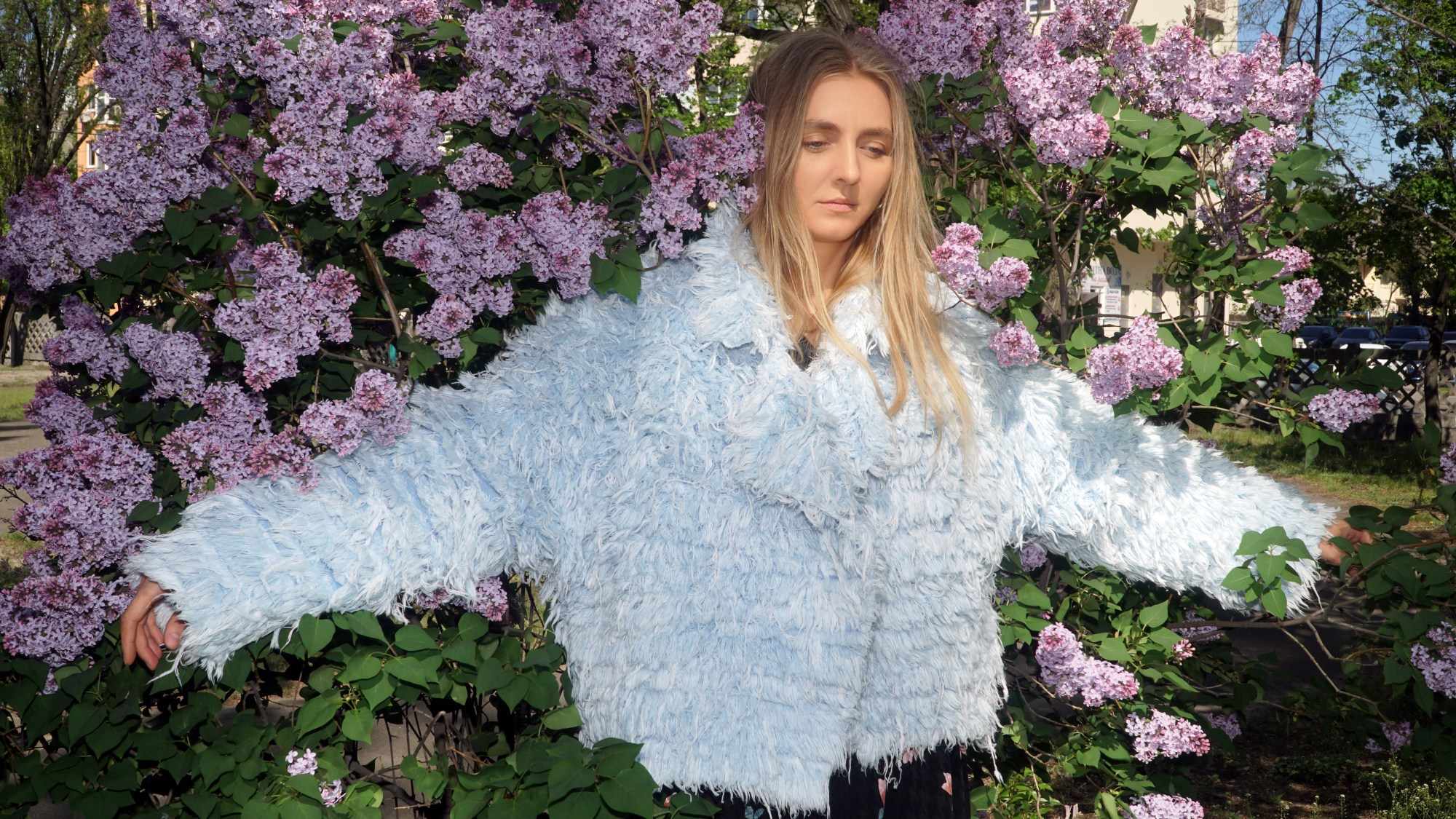You can probably not wear fur in 2018 and still consider yourself “woke”. With brands like Versace and Gucci going “fur free” in the last year, the time for high quality, realistic faux fur is now.
While the small Ukrainian brand, Ksenia Schnaider, cares about the environment and animals, they also just really like denim. So that’s what they make their fur out of.
The brand started as a Ukrainian love story, founded by Ksenia Schnaider, fashion designer, and her husband Anton Schnaider, graphic designer. Based in Kiev, the capital of Ukraine, they spoke to me over the phone in Russian, before dialling in their English-speaking colleague so that we could understand each other.
They don’t like sharing the story of how they met because it’s “like romantic”, but hinted that it involved a beach, breaking up with other partners and then re-kindling on New Years Eve. They started dating in 2010 and immediately brainstormed how they could design together. Their brand Ksenia Schnaider was created a year later.
Ksenia had been working in fashion for 10 years prior, with her own local street wear brand. Anton had been working as a graphic designer for a variety of clients, including Yandex or “the Russian Google”, but had always felt a connection to fashion. “When I was young, I was a personal shopper for my friends,” he says. Known in his neighbourhood for picking out and sewing clothing for friends, he was addicted to a style that he describes as having a Soviet Union Gosha Robchinskiy aesthetic.
The same well-known markets where Anton was a teenage “personal shopper” are now the places that the brand source all their denim and sportswear in order to repurpose it. Both Ksenia and Anton rave about the markets in Kiev, and have a “special guy” who goes to them three times a week to search for pieces. “For us it was very organic to use second-hand as our platform to grow,” says Ksenia. “Each season we have to wash, pick and stitch around 5,000 pairs of old jeans.”
Those jeans then become repurposed into “Demi Denims”, a layered shorts-over-pants style design that Ksenia created in 2016. Their “Demi Denim” is what Ksenia attributes to their international success – attracting celebrity wearers Bella Hadid and, most recently, Dua Lipa. The leftover denim from these products have now become what they call “denim fur”.
The idea initially started as a joke. One day Anton came into their studio, looked at the leftover jean fabric and said “it’s time we make fur from this.” Everyone initially laughed, then started to create a technology that could make that happen. From this, their AW18 “Denim Fur” jacket was born.
For Ksenia, her obsession with denim is rooted in the Soviet Union’s jean revolution. In her childhood, jeans had a cult status and were seen as being “really cool” to wear. With many shortages in the 90s, jeans became a luxury. “It’s was almost like having fur is a luxury elsewhere, but having a pair of jeans was a luxury here,” she says. She remembers her father having only one pair of jeans and her mother having to borrow the same pair.
With that context, “denim fur” might be the most Soviet Union item that there is. But it’s been most popular in Japan and South Korea. This, they say, is true for their entire collection. “Japanese girls tend to be more fashion forward,” says Anton. “ European clients want subtle and minimal clothes, but in Japan they are more open to the avant-garde.” Their stockists are around 40 stores worldwide, including Selfridges and Shopbop.
The couple takes inspiration from the “really bad graphic design” in Ukraine and explain that Ukraine has a lot of advertising on buildings, a large proportion of which is illegal printouts from citizens. “It’s too much information, too much ugliness. I cannot see architecture or trees. I see only visual spam,” says Ksenia. “I was really disappointed and stressed but I told myself that I need to find something in this and now find it interesting and draw inspiration from it.”
While wearing fur in Ukraine is popular, especially in the winter months, because the country is what Ksenia describes as “not very rich”, not everyone can afford it. The brand has had no institutional support and was started in a difficult time in a country with unstable political and economic circumstances. Despite this, the couple find inspiration from their country and upbringing and channel this into creativity. They, like other Ukrainian brands, are part of a wider movement growing the Ukrainian fashion industry.
The couple also gain inspiration from each other. They describe working together as “never not working”. And while Ksenia takes the lead in the garment design, it’s very obvious that Anton’s heavily involved in the conceptualisation. “In my professional cycle, people know me more as a guy who speaks more than he makes, but I make things too,” he says.
The main purpose of their fall/winter 18 collection was to make the brand as sustainable as possible. Next steps include becoming more experimental, producing a men’s line and moving (slightly) away from denim. And with their re-worked sportswear gaining steam, featuring in this month’s issue of Vogue Ukraine, they want to continue to push the boundaries with their collage-type tracksuits. Made from vintage 80s and 90s sportswear, the tracksuits reference Anton’s “gopnik” youth and passion for ordered chaos.
“It’s about making things for no reason,” say’s Anton. “Before we were trying to explain everything for the press like ‘These jeans were made because of this reason. Reason, reason, reason’. Now we try to be totally creative for no reason, like a random creative machine.” At this point he starts to make sewing machine noises and the couple both laugh and say something in Russian. This is later translated to “This is a more true way I think”.
